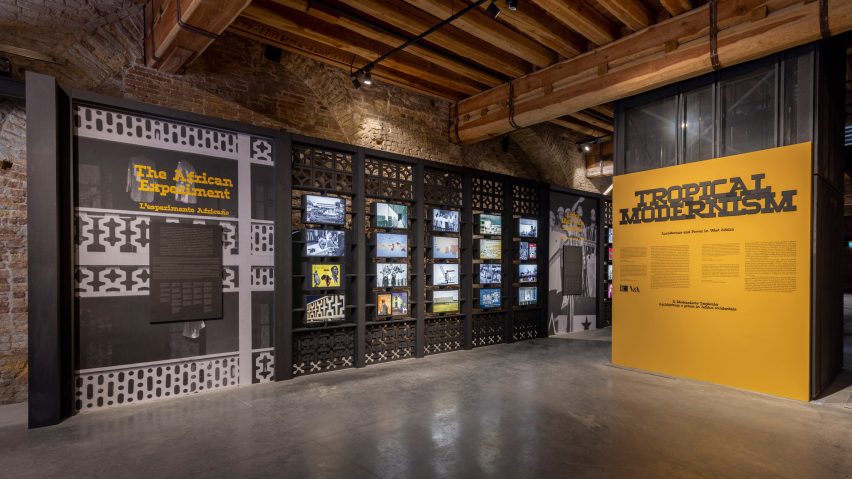A 36-metre-long brise soleil has been covered with screens showing the colonial history of tropical modernism at the Applied Arts Pavilion at the Venice Architecture Biennale.
Called Tropical Modernism: Architecture and Power in West Africa, this year's Applied Arts Pavilion exhibition is a collaboration between the UK's Victoria & Albert Museum (V&A) and the Venice Architecture Biennale.
Curated by Christopher Turner of the V&A and Nana Biamah-Ofosu and Bushra Mohamed of the Architectural Association (AA), the pavilion explores the origins and development of the tropical modernist style of architecture.
It examines how the movement changed from a tool to support British colonial rule in Africa to being adapted by free African nations into a uniquely African form of expression, starting with Ghana in 1957.
"The exhibition looks at the colonial origins of tropical modernism in British West Africa, and the survival of the style in the post-colonial period when it symbolised the independence and progressiveness of newly independent countries like Ghana, as well as the pan-African ambitions of its leader Kwame Nkrumah," Turner told Dezeen.
"We deliberately set out to complicate the history of tropical modernism by looking at the architecture against the anti-colonial struggle of the time, and by engaging with and centring African perspectives," he added.
The curators chose to display photographs, plans and other examples of tropical modernism in lightboxes that have been embedded in a large brise soleil screen inside the Applied Arts Pavilion.
This was designed by Biamah-Ofosu and Mohamed in a style loosely based on the facade of the University of Ibadan library in Nigeria, which was built by married architect duo Maxwell Fry and Jane Drew.
In the 1940s, the two adapted the minimalist modernist style to suit the conditions of British West Africa, creating the tools for tropical modernism. Fry also taught at the Department of Tropical Architecture at the AA, where architects were trained to work in the British colonies.
"The brise soleil, or sun breaker, was one of the classic attributes of tropical modernism, which adapted the International Style to the hot, humid climate of the tropics," Turner said.
"The 36-metre brise soleil used in the exhibition was inspired by the display used in the stained glass galleries at the V&A, and the large plate glass photographic slides in the AA archive devoted to the Department of Tropical Studies."
The centrepiece of the Tropical Modernism: Architecture and Power in West Africa exhibition is a 28-minute film that showcases 14 key buildings in the tropical modernist style still remaining in Ghana, including an Accra community centre designed by Fry and Drew and John Owusu Addo's Unity Hall.
It also features interviews with leading figures of the movement, including Addo, who was among the first generation of qualified African architects and who taught at the Kwame Nkrumah University of Science and Technology (KNUST) in Kumasi, Ghana.
The curators hope that showing the film will help preserve the buildings featured in it.
"Some of the buildings that we filmed in the 28-minute, three-screen film that is the centrepiece of our exhibition, and which was directed by the curators, are at risk from redevelopment and decay, and we wanted to celebrate them before they are potentially lost and contribute to the campaigns to save them," Turner said.
The curators also believe that tropical modernist buildings, which featured climate-control techniques and designs such as brise soleils, wide eaves and adjustable louvres, could teach valuable lessons about how to design for an increasingly hotter climate.
"The air-conditioning unit is now ubiquitous and this effectively ended tropical modernism, but obviously this has huge energy costs," Turner said.
"As we look to a new future in an era of climate change might tropical modernism, which used the latest building and environmental science then available to passively cool buildings, serve as a useful guide?"
Tropical Modernism: Architecture and Power in West Africa co-curators Biamah-Ofosu and Mohamed said the Applied Arts Pavilion exhibition was also designed to centre African architecture.
"By revisiting key buildings developed by prominent architects of the time, we are interested in the story of politics, power, resistance and freedom that this architecture came to represent in the post-independence Pan-African dream," they said.
"This exhibition presents an important moment in centering African architecture, architects, and historians, and addressing the omissions and erasure evident in the archives."
The exhibition ties in with the Venice Architecture Biennale's wider theme, Laboratory of the Future, and its focus on Africa. More than half the biennale's 89 participants hail from Africa or the African diaspora.
Ghanian-Scottish architect Lesley Lokko, who is the first person of African descent to have curated the Venice Architecture Biennale, told Dezeen that Africa's unique context makes it "a powerful place from which to examine the issues that will dominate the next century" in an exclusive interview.
Another pavilion at this year's Venice Architecture Biennale to explore and critique the legacy of British colonialism is the Australian pavilion, which focuses on several settlements named Queenstown and opened exclusively on Dezeen.
Other pavilions that were seen first on Dezeen include the Danish pavilion, the US pavilion, British pavilion and the Finnish pavilion that "declares the death of the flushing toilet".
Tropical Modernism: Architecture and Power in West Africa was organised together with the AA and KNUST.
The photography is courtesy of the Victoria & Albert Museum.
Dezeen is live reporting from the Venice Architecture Biennale, which takes place from 20 May to 26 November 2023. See Dezeen Events Guide for all the latest information you need to know to attend the event, as well as a list of other architecture and design events taking place around the world.

